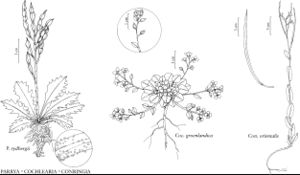Conringia
Enum., 160. 1759.
| Taxon | Illustrator ⠉ | |
|---|---|---|
 | Parrya rydbergii Cochlearia groenlandica Conringia orientalis | Yevonn Wilson-Ramsey Yevonn Wilson-Ramsey Yevonn Wilson-Ramsey |
Plants not scapose; (usually glaucous). Stems erect, unbranched or branched proximally. Leaves basal and cauline; subsessile or sessile; basal not rosulate, subsessile, blade margins usually entire; cauline blade (base cordate-amplexicaul or, rarely, auriculate), margins usually entire, rarely crenulate. Racemes (corymbose, several-flowered). Fruiting pedicels ascending, stout (almost as thick as fruit, or, rarely, much narrower). Flowers: sepals oblong; petals usually narrowly obovate, rarely oblanceolate, claw differentiated from blade [undifferentiated], (apex obtuse); stamens slightly tetradynamous; filaments not dilated, slender; anthers oblong (base slightly sagittate); nectar glands lateral, median glands often absent. Fruits sessile, linear, torulose, 4-angled or terete; valves each with prominent midvein; replum rounded; septum complete; stigmas capitate-flattened, entire. Seeds not winged, oblong [ellipsoid]; seed-coat (papillose), copiously mucilaginous (granular) when wetted; cotyledons incumbent. x = 7 [9].
Distribution
Introduced; c Europe, e Mediterranean region, Asia (Afghanistan), Asia (Pakistan), also in Mexico, nw Africa, Australia
Discussion
Species 6 (1 in the flora).
Selected References
None.
Lower Taxa
"elongated" is not a number."thick" is not a number.